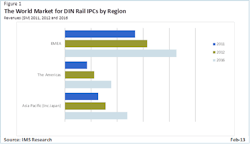In a report by IMS Research, part of IHS Inc. (www.ihs.com), senior analyst for IPCs, Toby Colquhoun, laid out the reasons for DIN rail dominance: “First, control engineers have increasing confidence in PC-based technology for critical tasks, whereas in the past using a programmable logic controller (PLC) was the only acceptable solution. Second, most manufacturing organizations continue to connect factory and enterprise networks. As enterprise networks are typically PC-based, DIN rail IPCs allow seamless integration between decision makers and the factory floor.”
Another trend driving interest is that "DIN rail IPC suppliers have reacted appropriately to customer requirements. They have begun to offer next-generation products," said Colquhoun. In 2011, Advantech and Beckhoff were estimated to account for most revenues in this market. IHS projects the future market structure will differ as new DIN rail IPC suppliers such as Siemens, IEI and Nexcom offer new products and reach new customers.
Beyond traditional industrial automation applications, Colquhoun said DIN rail IPC adoption continues to grow in transportation and building automation. IHS projects a revenue compound annual growth rate (CAGR) of 12 percent between 2011 and 2016, which is significantly higher than the IPC market average of 9 percent, he said.
About the Author
Adam Madison
Associate Editor

Leaders relevant to this article:
